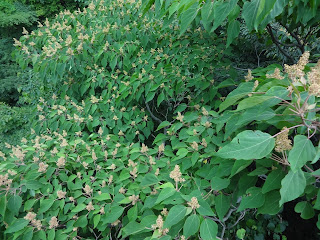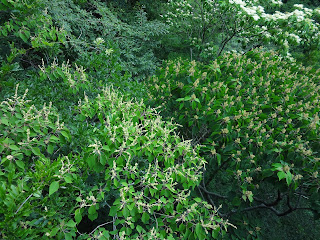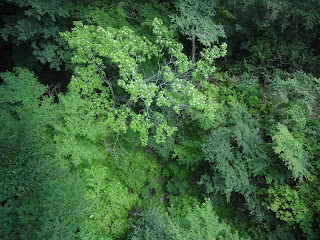Kanagawa
Forest Instructors’ Association has secretly famous experts who can perform as
sentinels of environment in Kanagawa Prefecture. Several senior members are
active policy makers for environmental revitalization in the Prefecture. Some
others are for more than 20 years crucial contributors to the Nature Revitalization Plan for Tanzawa-Oyama Quasi-National Park 丹沢大山自然再生計画. Their
voice is based on scientific data collection, patiently continued for decades
in the forests and mountains of Kanagawa. I’ve heard some of my seniors were
retired professors of the field, but majority were enthusiastic “amateurs” who have
kept learning and reached to the level to make presentations for academic
meetings. i.e. Perfect example for the achievement of citizen scientists ... Er
well, for a freshman instructor like me, they are Hall-of-Famers, and so,
beyond my reach. But, yeah, Rome was not built in a day, and a freshman is an
easy assistant for them to collect data in the forest. Recently, I’ve joined
their line-census for vegetation along Hadano Forestry Road 秦野林道. The day was a fun, and, … well, as a whole, that
was really an educational experience.
 |
| Experts of citizen science are entering the forest. |
This
post is the second time I tell you about Hadano Forestry Road. (The first one
was about Gabicho, aka Chinese hwamei, remember?) Actually, the area is like a
main activity field for Kanagawa Forest Instructors’ Association, and hence I’m
visiting the place frequently these days ... Anyway, the 13.7K road connects
Yadoriki Community 寄 of Matsuda Town 松田町 and Kurokura Community 玄倉 of Yamakita Town 山北町. It’s a
blacktop road wide enough for a car to pass, though it’s for permit-holding cars
only. In theory, if we walk with a pace of 4K per hour, we should be able to
conquer the entire itinerary in one day. Hmmmm, I’ve learned if we collect
plant data along the road, it was more like 1K per hour at best even for the
veterans. Do you think it leisurely? Well, please think again.
 |
| A Map of Hadano Forestry Road, provided at the entrance of the road. I tell you this map is well-crafted. |
 |
| Indeed, the road is pleasant enough for light hiking. |
In early
summer, yellow flowers of Mallotus
japonicas is in full-bloom along Hadano Forestry Road. The plant is
dioecious. So, we have to differentiate male and female trees and record
accordingly. “Hey, Freshman! Look at this. It’s a male flower for Mallotus japonicas. Those fluffy parts
are for their stamens. You see?” Figuring out such differences in the trees of
a valley at least 10m up is, I tell you, not easy. Or, discerning Carpinus laxiflora from Caprinus tschonoskii is tricky. Text
books say when its leaf has less than 12 lateral-veins, it’s Carpinus laxiflora, whereas 12-15 veins
are for Caprinus tschonoskii. Now you
have a suspect tree 5m down on the slope from the forestry road. At least a
very good binocular is needed. Oh yeah. Those veterans could spot noteworthy
specimen along the road quickly, identify them, and then gave me their
diagnosis with plants’ name. I took a photo and a note, together with the label
of a plant, a place we’ve found them, and the condition of the plant (color of
leaves, flowering, number of specimen found, insects’ trace, …).
 |
| The girl-flowers for Mallotus japonicas are chatting merrily here. |
 |
| Male and female flowers of Mallotus japonicas with a young fruit of Caprinus japonica and a leaf of Acer cissifolium. |
 |
| Boys and girls of Mallotus japonicas are standing nearby here. |
 |
| Don’t
you think those flowers of Cornus kousa look floating in the ocean of green leaves … |
Telling
you the truth, when I started to attend training courses for forest volunteers,
which includes the seminars presided by academic experts of the nature, I found
my brain was overwhelmed by massive amount of new information from forests. Is
it Polygonatum odoratum, polygonatum
falcatum, Polygonatum involucratum, or Disporum sessile? PANIC!!!! I think it
was because I was clueless where to see in order for identifying a plant. In
contrast, my senior forest volunteers know the thing, and take a cool step-by-step
approach to classify a subject methodically. Even though, “Yes, in today’s
DNA-based cataloging, maples are a part of Sapindaceae,
and Aceraceae family was merged with Sapindaceae.” “Yes, we have to be
careful here …” The process goes like this for each finding. It’s completely
different from sports hiking to gain mileage or altitude quickly. The time in a
forest flows very slowly, with an intellectual tension. That was a fun!
Besides, at least on that evening, my feet were easy enough compared with them
after a mountaineering day … My seniors gave me homework. “So, Naomi, you
create a record of today’ study and email it to us. We’ll help you to check it
collectively. Don’t worry.” Sounds very easy and kind offer for help, isn’t it?
 |
| The instructors are discussing … it’s fruits of Deutzia crenata. |
 |
| These
black-ish balls on the stem of Miscanthus
sinensis are barns for aphids ants created. The famous symbiotic relationship is in action! |
 |
| Large Phytolacca americana are easy to find along Hadano Forestry Road. They came Japan some 150 years ago, and expanding their territory since then … |
The
Kanagawa Forest Instructors’ Association has a format to record each of these findings,
and I was tasked to fill the cells of the spreadsheet based on my note. That
has been, I would say, very complicated procedure. On my desk every evening for
a while, I matched my photo and memos, google-sought to figure out the
characteristics of each plant to identify the picture, and double-checked APG
Plant Classification System if I was correctly recording the data in the latest
denomination. Is this photo is on the right or left side of the road? Which
bridge we were crossing when I wrote this memo? Etc. etc. … It took 10 nights
to complete a form with the data collected during 4 hours’ walk. At the end of
the day, I felt I’ve done something. Very educational experience, I tell you.
 |
| Phew! An
abbreviated (and translated) version of my report. Actually, on that day we recorded more than 100 kinds of plants including some endangered species. |
My
seniors told me they are now circulating my excel table to multiple-examination
… Oh My Buddha … have I created a record receiving at least “Pass” grade? Being
a sentinel of environment is a task required to be meticulous and patient …
Don’t rush. I’ve learned a lesson.
 |
| Cute. I’m still carrying last week’s theme.😍 |
If you find an environmental issues
in Tanzawa, please make a contact with Kanagawa Natural Environment Conservation Center 神奈川県自然環境保全センター
657 Nanasawa, Atsugi City, 243-0121 〒243-0121 厚木市七沢657
Phone: 046-248-0323
You can send an enquiry to them by
clicking the bottom line of their homepage at http://www.pref.kanagawa.jp/div/1644/




No comments:
Post a Comment